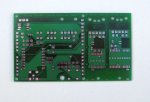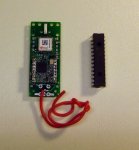Version 2 of HABAXE will be using a RFM98 transceiver, this uses Semtechs new SX1278 LoRa device.
The device is similar in size and capability to the RFM22B. It can generate FSK RTTY too but the LoRa telemetry from the Semtech device has much greater range than the FSK data telemetry produced by the RFM22B.
A benefit of using data telemetry for tracking is that a receiver can be left running unattended as the receivers are fairly tolerant of frequency changes by the transmitter, unlike FSK RTTY which needs frequent manual re-tuning.
I have carried out range comparisons of the SX1278 device versus the RFM22B (Si4432 based) first on Tenby beach with Arduino based code, a series of 1km across town tests and eventually a 40km LOS test between two hilltops with PICAXE code. The LoRa devices show in all these tests between 17dB and 19dB of signal gain over the performance of the RFM22B when used at 1000bps (40km needed only 2mW !). Using the LoRa device at 100bps yields a further 10dB improvement. 17dB equates to 7 times further distance, 27db to 22 times further distance.
Now 2mW was the limit of reception at 40km, so you can conclude that the RX needed at least -114dBm of signal to reliably operate. However the LoRa calculator claims the sensitivity at the bandwidth and spreading factor was -131dBm, so where has the missing 17dBm gone ?
The sensitivity quoted is in reality a figure that cannot be used, at least not on Earth, the background noise level is too high. I checked and a typical background noise level reported by the SX1278 RSSI was -100dBm. Where the SX1278 device is getting its real world performance from is its ability to receive signals below the noise level. The signal to noise ratio for the spreading factor used in the 40km LOS test (8) is quoted as -10dBm, so the receiver should work if the signal was 10dB below the noise level. 10db below a noise level of around -100dBm is -110dBm, close to the signal level that 40km\2mw would have produced.
Putting the LOS test results into distances would produce for a power of 10mW a LOS range of;
1000bps – 90km
100bps – 280km
On simple ¼ wave wires !
The addition of a vertical gain antenna and\or LNA should improve on these distances.
If you are going to use LoRa data telemetry for HAB tracking you need a LoRa receiver. I had previously designed my own complete receiver boards using a PICAXE 28X2, but a suggestion by forum user MFB, provided a cheaper and simpler solution.
Rev Ed make the AXE401 Shield base, it uses a 28X2 and takes most standard Arduino shields. So the HABAXE2 Shield was born, see pictures. It's a simple PCB for the RFM98 about 50mm x 53mm and plugs into the AXE401 shield base or indeed an Arduino Uno if you must.
The shield can just be used as a data telemetry transceiver; all you need to fit is the RFM98, the pin headers and a bit of wire for an antenna.
There are also connectors for an external GPS, a serial LCD display and external buzzer. There are 2 LEDS, 2 Switches, a DS18B20* temperature sensor and an on board buzzer. So for larger HAB payloads the shield could, together with the AXE401, be used as a HAB tracker in its own right.
The shield can be used with a variety of GPS, although the software may need to be tweaked for different modules.
The shield does make playing with and testing different GPSs and the RFM98 quite easy, and it has enough I\0 to be used as a HAB tracker for larger payloads.
More updates and links to software later.
The device is similar in size and capability to the RFM22B. It can generate FSK RTTY too but the LoRa telemetry from the Semtech device has much greater range than the FSK data telemetry produced by the RFM22B.
A benefit of using data telemetry for tracking is that a receiver can be left running unattended as the receivers are fairly tolerant of frequency changes by the transmitter, unlike FSK RTTY which needs frequent manual re-tuning.
I have carried out range comparisons of the SX1278 device versus the RFM22B (Si4432 based) first on Tenby beach with Arduino based code, a series of 1km across town tests and eventually a 40km LOS test between two hilltops with PICAXE code. The LoRa devices show in all these tests between 17dB and 19dB of signal gain over the performance of the RFM22B when used at 1000bps (40km needed only 2mW !). Using the LoRa device at 100bps yields a further 10dB improvement. 17dB equates to 7 times further distance, 27db to 22 times further distance.
Now 2mW was the limit of reception at 40km, so you can conclude that the RX needed at least -114dBm of signal to reliably operate. However the LoRa calculator claims the sensitivity at the bandwidth and spreading factor was -131dBm, so where has the missing 17dBm gone ?
The sensitivity quoted is in reality a figure that cannot be used, at least not on Earth, the background noise level is too high. I checked and a typical background noise level reported by the SX1278 RSSI was -100dBm. Where the SX1278 device is getting its real world performance from is its ability to receive signals below the noise level. The signal to noise ratio for the spreading factor used in the 40km LOS test (8) is quoted as -10dBm, so the receiver should work if the signal was 10dB below the noise level. 10db below a noise level of around -100dBm is -110dBm, close to the signal level that 40km\2mw would have produced.
Putting the LOS test results into distances would produce for a power of 10mW a LOS range of;
1000bps – 90km
100bps – 280km
On simple ¼ wave wires !
The addition of a vertical gain antenna and\or LNA should improve on these distances.
If you are going to use LoRa data telemetry for HAB tracking you need a LoRa receiver. I had previously designed my own complete receiver boards using a PICAXE 28X2, but a suggestion by forum user MFB, provided a cheaper and simpler solution.
Rev Ed make the AXE401 Shield base, it uses a 28X2 and takes most standard Arduino shields. So the HABAXE2 Shield was born, see pictures. It's a simple PCB for the RFM98 about 50mm x 53mm and plugs into the AXE401 shield base or indeed an Arduino Uno if you must.
The shield can just be used as a data telemetry transceiver; all you need to fit is the RFM98, the pin headers and a bit of wire for an antenna.
There are also connectors for an external GPS, a serial LCD display and external buzzer. There are 2 LEDS, 2 Switches, a DS18B20* temperature sensor and an on board buzzer. So for larger HAB payloads the shield could, together with the AXE401, be used as a HAB tracker in its own right.
The shield can be used with a variety of GPS, although the software may need to be tweaked for different modules.
The shield does make playing with and testing different GPSs and the RFM98 quite easy, and it has enough I\0 to be used as a HAB tracker for larger payloads.
More updates and links to software later.
Attachments
-
42 KB Views: 84
-
50.5 KB Views: 75
Last edited:






